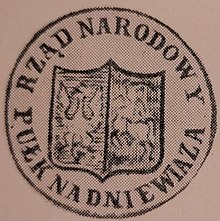Tomasz Kuszłejko
Tomasz Egidiusz Kuszłejko | |
|---|---|
| Born | 1821 |
| Died | 1894 |
| Noble family | Kuszłejko family |

Tomasz Egidiusz Kuszłejko (Lithuanian: Tomas Egidijus Kušleika; 1821 – 1894) was a participant of the Uprising of 1863.
Early life
[edit]Kuszłejko came from the Lithuanian noble Kuszłejko family, he was born in Trankiniai in Samogitia.[1][2] He was an officer of the Imperial Russian Army.[2] He went into reserve and lived in the Bartkūniškiai manor near Kėdainiai.[2] Tomasz Kuszłejko was the owner of the Bartkūniškis manor.[3]
Uprising of 1863
[edit]In March 1863, he was mobilised by Bolesław Dłuski to form a unit in the Krakės forests, near his manor.[4] His unit of about 800 rebels, mostly peasants, concentrated in the Krakiai forest near Kuszłejko's manor, chose him as commander.[2] This unit was called the Nevėžis Regiment[2] (Polish: pułk nadniewiażski).[5] In addition to organising the unit, Kuszłejko enfranchised the peasants of his manor.[6] The regiment fought between Krakės and Lenčiai close to Ažytėnai, then in Varnioniai near Daugėlaičiai, and finally near Rekečiai and near Viekšniai (9 June 1863).[2] Kuszłejko recruited new rebels through the regiment's fighters, inciting the public against Russian occupation.[2] Among the recruiters was Adomas Bitė, who was very trusted by the local peasants.[7] The regiment was later divided into smaller independent groups.[2]
In emigration
[edit]In autumn 1863, he emigrated and lived in France. He took an active part in the political life of emigration. He was a member of the Union of Polish Emigrants, as head of the Montparnasse commune, and a member of the Lithuanian Delegation, set up to settle the so-called "Lithuanian sums".[5] In 1867, he was one of the initiators of the split and the formation of the right-wing so-called "Ogół" Organisation.[5]
Last years
[edit]Probably after 1868 he returned from emigration and settled in Galicia, mostly Lviv, from 1868.[2] For several years he was involved in a court dispute over part of his estate, which the Kaniewski brothers were trying to seize.[5] He died from a heart attack in Zamarstyniv in 1894.[1]
References
[edit]- ^ a b Dyniewicz 1894.
- ^ a b c d e f g h i Maksimaitienė 2007, p. 336.
- ^ Žalpiene 2006, p. 15.
- ^ Łaniec 2002, p. 44.
- ^ a b c d Kozłowski 1968, p. 310.
- ^ Fajnhauz 1999, p. 189.
- ^ Sruogienė 1963, p. 200.
Sources
[edit]- Dyniewicz, Władysław (1894). "Obituary". Gazeta Polska w Chicago (in Polish). Chicago.
- Fajnhauz, Dawid (1999). 1863: Litwa i Białoruś (in Polish). Neriton. p. 189. ISBN 9788386842599.
- Kozłowski, Eligiusz (1968). "Tomasz Egidiusz Kuszłejko". Polski Słownik Biograficzny (in Polish). Vol. 13. Wrocław. p. 310.
{{cite encyclopedia}}: CS1 maint: location missing publisher (link) - Łaniec, Stanisław (2002). Dowódcy i bohaterowie powstania styczniowego na Żmudzi (in Polish). Toruń.
{{cite book}}: CS1 maint: location missing publisher (link) - Maksimaitienė, Ona (2007). "Tomas Egidijus Kušleika". Visuotinė lietuvių enciklopedija (in Lithuanian). Vol. XI (Kremacija-Lenzo taisyklė). Vilnius: Mokslo ir enciklopedijų leidybos institutas. p. 336.
- Sruogienė, V. (September 1963). "Sukilimo vadai" (PDF). Karys (in Lithuanian). 7 (1394): 200.
- Wyczańska, Krystyna (1957). Polacy w Komunie Paryskiej 1871 r. (in Polish). Wydawnictwo Ministerstwa Obrony Narodowej. p. 132.
- Žalpiene, Danute (2006). Žemaitijos dvarai - pasipriešinimo centrai prieš Rusijos imperija̜ XIX a: konferencijos pranešimai (in Lithuanian). Šiauliai: Saulės delta. p. 15. ISBN 978-9955-522-97-3.
